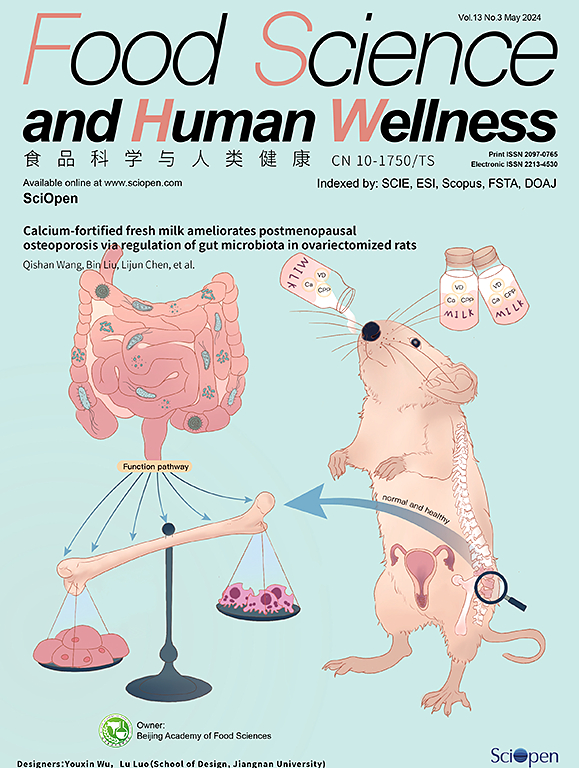黄曲霉毒素神经毒性的分子机制和潜在的神经保护剂
IF 7.4
1区 农林科学
Q1 FOOD SCIENCE & TECHNOLOGY
引用次数: 0
摘要
黄曲霉毒素(AFTs)是最臭名昭著的一类致命霉菌毒素,由农作物上的某些真菌产生。黄曲霉毒素对哺乳动物有剧毒,已知会造成一系列有害影响,包括神经、肝、肾和免疫毒性。在这篇原创性综述中,我们总结了黄曲霉毒素诱发神经毒性的机制以及新型神经保护剂的临床潜力。黄曲霉毒素 B1(AFB1)是已发现的 21 种黄曲霉毒素中毒性最强的同系物。最近的研究表明,动物和人类通过食物摄入黄曲霉毒素 B1 和/或其代谢物往往会导致致命的神经中毒。动物研究表明,摄入 AFB1 可诱发异常行为变化,包括焦虑、嗜睡障碍、抑郁样行为、认知、学习和记忆缺陷以及摄食行为减少。从机理上讲,暴露于 AFB1 与脂质过氧化、非酶和酶抗氧化防御系统的消减以及神经递质水平的下降有关。研究还表明,暴露于 AFB1 会诱发脑组织的 DNA 损伤、细胞凋亡、热凋亡和线粒体功能障碍。一些信号通路,包括 gasdermin D、toll like receptor 2 (TLR2)、TLR4、Akt、NF-κB、ERK/MAPK、蛋白激酶 C (PKC) 和线粒体凋亡通路已被证明参与了 AFB1 诱导的神经元或星形胶质细胞死亡。通过小分子药物(如槲皮素、姜黄素、没食子酸和富马酸二甲酯)、中草药提取物(如朝鲜蓟叶提取物、车前子乙醇提取物、南瓜提取物和鳄梨茶)和益生菌补充剂来靶向这些通路,可有效改善 AFB1 诱导的神经行为异常和神经毒性。迄今为止,AFB1诱导神经毒性的确切分子机制和潜在的神经保护剂仍不清楚。本综述对 AFB1 诱导的神经毒性的临床表现、分子机制和潜在的神经保护剂进行了最广泛的概述。希望这篇内容广泛的综述能提供有价值的见解,并引发更广泛的讨论,从而开发出有效的黄曲霉毒素神经保护剂。本文章由计算机程序翻译,如有差异,请以英文原文为准。
Molecular mechanisms of aflatoxin neurotoxicity and potential neuroprotective agents
Aflatoxins (AFTs) represent one of the most notorious classes of deadly mycotoxins produced by certain fungi that are found on agricultural crops. Aflatoxins are highly toxic to mammals and are known to cause a series of detrimental effects, including neuro-, hepato-, nephron-, and immuno-toxicity. In this original review we summarize the mechanisms of aflatoxin-induced neurotoxicity and the clinical potential of novel neuroprotective agents. Aflatoxin B1 (AFB1) is the most toxic congener among the 21 identified AFTs. Recent studies have shown that food borne exposure to AFB1 and/or its metabolites often leads to fatal neurotoxicity in animals and humans. Animal studies indicated that AFB1 exposure could induce abnormal behavioral changes, including anxiety, lethargy disorders, depression-like behavior, cognitive, learning and memory defects, and decreased feeding behavior. Mechanistically, AFB1 exposure has been associated with lipid peroxidation, ablation of non-enzymatic and enzymatic antioxidant defense systems and decreased neurotransmitter levels. AFB1 exposure has also been shown to induce DNA damage, apoptosis, pyroptosis, and mitochondrial dysfunction in the brain tissue. Several signaling pathways, including gasdermin D, toll like receptor 2 (TLR2), TLR4, Akt, NF-κB, ERK/MAPK, protein kinase C (PKC), and mitochondrial apoptotic pathways have been shown to participate in AFB1-induced neuronal or astrocyte cell death. Targeting these pathways by small molecules (e.g., quercetin, curcumin, and gallic acid, and dimethyl fumarate), Chinese herbal extracts (e.g., Artichoke leaf extract, Chelidonium majus ethanolic extract, pumpkin extract, and Crocus sativus L. tea), and probiotic supplements could effectively improve AFB1-induced neurobehavioral abnormalities and neurotoxicity. To date, the precise molecular mechanisms of AFB1-induced neurotoxicity and potential neuroprotective agents remain unclear. In the present review, the clinical manifestations, molecular mechanisms, and potential neuroprotective agents of AFB1-induced neurotoxicity are summarized in the broadest overview. It is most hopeful that this broad reaching review provides valuable insights and stimulates broader discussion to develop the effective neuroprotective agents against aflatoxins.
求助全文
通过发布文献求助,成功后即可免费获取论文全文。
去求助
来源期刊

Food Science and Human Wellness
Agricultural and Biological Sciences-Food Science
CiteScore
8.30
自引率
5.70%
发文量
80
审稿时长
28 days
期刊介绍:
Food Science and Human Wellness is an international peer-reviewed journal that provides a forum for the dissemination of the latest scientific results in food science, nutriology, immunology and cross-field research. Articles must present information that is novel, has high impact and interest, and is of high scientific quality. By their effort, it has been developed to promote the public awareness on diet, advocate healthy diet, reduce the harm caused by unreasonable dietary habit, and directs healthy food development for food industrial producers.
 求助内容:
求助内容: 应助结果提醒方式:
应助结果提醒方式:


